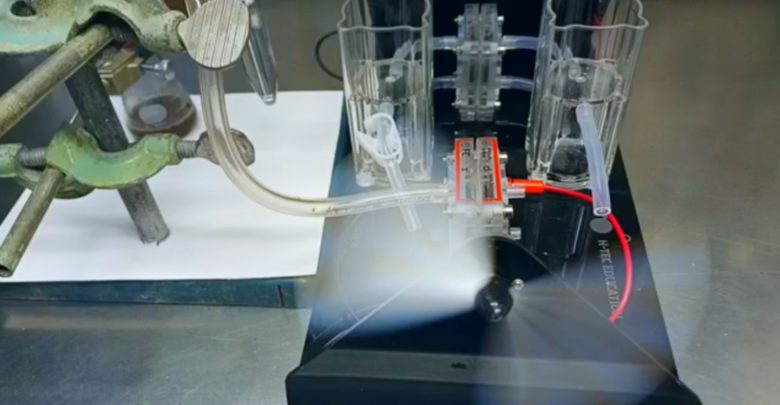 Dark Matter Materials
Dark Matter MaterialsRobin Hamilton, a senior research associate in the department of chemistry at the University of Alberta, was creating an electrode for a student’s chemistry project. In the process, Hamilton accidentally discovered a way to generate pure hydrogen and purify water at the same time.
The reagent and catalyst Hamilton used made a new catalyst-reagent composite — a reagent allows a chemical reaction to happen, and a catalyst speeds up a chemical reaction. The new catalyst splits the hydrogen and oxygen when put in water. This results in pure hydrogen, which can generate electricity and create clean drinking water when put in a fuel cell.
The catalyst is also reusable after the initial reaction. This is beneficial as there is a “circular economy” around the catalyst, Hamilton added.
According to Hamilton, there are four ways to obtain the energy required for splitting water into hydrogen and oxygen: heat, electricity, sunlight, and chemical energy. This newly discovered process uses chemical energy.
“The reagent is giving us all the energy we need to actually split water. It doesn’t do this unless our catalyst is present under the conditions that we use,” Hamilton said.
Hamilton added that the chemical reaction itself, without the catalyst present, was discovered a long time ago. The mild conditions for hydrogen production were what made the reaction unusual.
“[Without this catalyst,] you have to use either heavily processed material, or you have to heat it up to over 100 degrees Celsius, or you have to add a very concentrated base solution. So, pretty harsh conditions,” Hamilton said.
“The conditions we’re working with are nowhere near that. Everything is at room temperature, and mildly basic. If you spilled the water on your hands you wouldn’t get burned.”
There are more beneficial aspects of this reaction other than producing hydrogen, Hamilton added. Other water electrolysis systems — which use electricity to split water into hydrogen and oxygen — use distilled water. According to Hamilton, this catalyst can react with any kind of water to create hydrogen, not just clean, filtered water. In fact, saltwater works better.
Hamilton said that the hydrogen produced from non-potable water — water that is not suitable for drinking — can have several uses. It can go into a hydrogen combustion system that makes water, taking out the salts in the process and purifying the water. Putting hydrogen into a hydrogen fuel cell also makes purified water.
“There’s a lot of benefit from using non-potable water. And if you do it right, you’ll get potable water out of it in the end,” he said.
CEO of Dark Matter Materials says company is looking “to build systems that people could use” to produce fuel and clean water
David Antoniuk is chief executive officer of Dark Matter Materials Inc. (DMM), and chief executive officer and co-founder of Applied Quantum Materials Inc. (AQM). Hamilton approached Antoniuk after his discovery to get help with production.
“We took a look at the technology and the implications. It was too big to be absorbed under AQM,” Antoniuk said. AQM created DMM as a solution — the new company is able to provide the resources needed for hydrogen production.
DMM is currently focusing on building systems that increase the scale of the chemical reactor that produces hydrogen, and increasing catalyst production.
“These systems could be practical in a home. For example, you take your dirty grey water and run it through the system. It produces heat and potentially electricity through a fuel cell. Then, you have clean water going back into the sewer system,” Antoniuk said.
“Or you can just recycle the water and keep using it over and over again in the home. It would be a more efficient process for homeowners, instead of burning natural gas all the time.”
Antoniuk added that this process could be useful in remote places with limited access to hydrogen, electricity, and clean water.
“Some Indigenous communities have no access to infrastructure and electrical grids, and there’s no hydrogen up there. But, they have a lot of water,” Antoniuk said.
“We can take that water — which doesn’t have to be purified — put it in our system, and it could produce fuel, electricity, and you get clean drinking water.”
According to Antoniuk, DMM is looking for opportunities to produce hydrogen at a large industrial scale. This may include water desalinization systems, or burning hydrogen in a cement kiln to reduce greenhouse gas emissions from cement manufacturers.
“Our goal for the next little while is to not only build the capacity for catalyst production, but also to build systems that people could use.”




